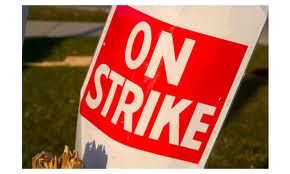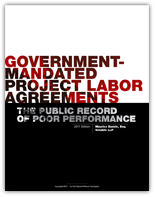Construction unions market project labor agreements (PLAs) to public and private construction owners as a tool to guarantee labor peace on construction projects.
But recent examples of strikes on PLA projects in NYC and other areas across the U.S. call into question the value of these anti-competitive schemes designed steer contracts to union contractors and union members.
Big Labor knows that strikes, work stoppages, slowdowns and other labor unrest caused by union bosses and rank and file members can shut down a jobsite and delay the opening of a project, potentially costing construction owners time and money and harming the project’s end-user. In fact, PLAs were originally developed in the 1930s as a solution to prevent costly strikes on important large-scale public works projects like dams during an era when more than 80 percent of the U.S. construction workforce belonged to a union.
Today, just 13.1 percent of the construction industry workforce belongs to a union, so union bosses leverage the threat of union-led strikes to acquire commitments from public and private owners to mandate PLAs in order to create more jobs for union members and increase the unionized sector’s dwindling market share.

Big Labor bosses load PLAs with terms and conditions favorable to union leaders, union members and unionized contractors hand-picked to receive preferential treatment by a PLA.
These agreements typically force contractors to hire all or most of their tradespeople from union hiring halls, pay into union pension and benefit plans, follow inefficient union work rules, and hire apprentices exclusively from union apprenticeship programs. As a condition of working on a PLA project, provisions in typical PLAs can also force nonunion employees to: (1) join a union or receive unwanted union representation; (2) follow archaic work rules; (3) pay union dues and initiation fees; and (4) forfeit any employer and employee contributions to union benefit plans unless they join a union and become vested in these plans.
Irrespective of whether a project is subject to a PLA mandate, the wage and benefit rates of tradespeople are usually already subject to government-determined prevailing wage rates that frequently mirror collectively-bargained rates contained in each specific trade union’s contract (which typically exceeds free market wage and benefit rates).
Any contractor is technically allowed to bid on a project subjected to a government-mandated PLA, but few nonunion contractors do. As last week’s Boston Herald editorial explains:
But in practical terms, they [PLAs] box out non-union companies (whose tradespeople are of course licensed by the state and must comply with all workplace safety rules), drive up public construction project costs and allow union-friendly politicians to curry favor with organized labor.In short, government-mandated PLAs are schemes that help unions increase market share and deny qualified contractors and their skilled workforces a fair opportunity to bid and win taxpayer funded construction contracts.
PLA mandates cost taxpayers a bundle, needlessly limit competition, flirt with extortion and are particularly unsettling because nonunion workers – those that are effectively eliminated from PLA projects – don’t engage in strikes or jobsite unrest.

But the simple truth is that PLAs sometimes fail to prevent union strikes and labor unrest on PLA jobsites.
Yesterday Crain’s New York Business reported that a number of NYC jobsites were shut down and/or experienced strikes by concrete workers after “negotiations between Laborers’ Locals 6a, 18a and 20 of the Cement and Concrete Workers of New York and the Cement League broke down over demands by the industry association for wage cuts” (“Concrete workers walk off World Trade Center job,” 8/1/11):
“Workers are not supposed to strike at sites where developers and unions inked project labor agreements, but an industry source said concrete workers did not show up Monday for their jobs at the new Weill Cornell Medical Center research building on East 69th Street, a project that does have such an agreement. The source said a request for an arbitration hearing was made to the Building and Construction Trades Council.”

The Wall Street Journal reported that in addition to the Weill Cornell Medical Center, the Barclays Center at Atlantic Yards in Brooklyn – the new basketball arena for the NBA’s New York Nets – suffered a strike despite a PLA. (“Work Stoppage at WTC: Concrete Union Laborers Threaten Picket Line as Contract Negotiations Continue,” 8/1/11).
Here’s More from the WSJ on the cause of the strike:
More than two dozen union contracts expired in June. Most unions have since signed deals. In addition to cement workers, sheet metal workers still need to hammer out a new deal.Earlier this year, NY building associations representing contractors signatory to union agreements with numerous trades did not attempt to cut wages and benefits in contract negotiations but instead asked for reforms to inefficient work rules contained in union agreements that increase costs and reduce productivity. They cited changes in work rules outlined in the Regional Plan Association report, Construction Labor Costs in New York City: A Moment of Opportunity, which found that “arcane union work rules, inefficient practices, and featherbedding impose 20 percent to 30 percent in excess costs, leading to dramatic increase in nonunion work on NYC construction sites.”
The cost of unionized labor has been a central theme in talks between contractors and the concrete workers, according to a person familiar with the matter.
Contractors want the concrete workers to accept 20% less in wages and benefits for residential construction work versus commercial work, the person said. The unions oppose that.
Concrete workers in New York earned $66.58 an hour in base pay and benefits last year, according to the Engineer New-Record, a trade publication.
“We can’t afford the strike [because of the economy], but we can’t afford to take a 20% pay cut,” said Mr. Montalbano, the concrete worker. “If it was up to me, we should freeze our wages until the economy gets better but don’t cut our wages.”
The study also mentioned that NYC developers complained that PLAs were a failure and delivered little to no promised cost savings:
For years, even Big Labor bosses have admitted that a PLAs’ promise to prevent strikes and labor unrest is often broken, resulting in lost market share for union contractors.“Management has been almost universally disappointed with the actual savings achieved—2 to 4 percent rather than the promised 20 percent.”

For example, Joseph Hunt, the President of the Ironworkers Union, devoted his President’s Page column (“Ironworkers Have Tradition and Honor in Project Labor Agreements“) in the February 2008 edition of The Ironworker to inform the Ironworkers Brotherhood that:
“Once again, it is my duty to inform you there has been an increase in work stoppages on jobs governed by project labor agreements.”Earlier this summer, the NYC Building Trades even issued this warning in anticipation of union members ignoring the union promise not to strike on PLA projects:
“A No Work Stoppage-No Lock Out clause is the most important because it is the foremost reason owners and contractors are willing to use the agreement [a PLA] to commit to an all-union job.”
“They [owners] have a choice and they know that the non-union do not have jurisdictional disputers nor do they have strikes.”
“Every PLA includes a no strike/no-lock out clause. Every affiliate signatory to a PLA has an obligation to honor this clause. Any strikes in support of other unions on strike would be a breach of a PLA. Any lawsuit or other proceeding resulting from such a breach may seek monetary damages for any delay caused to a PLA job, which could be substantial.”A chapter in Maury Baskin’s report, Government-Mandated Project Labor Agreements: The Public Record of Poor Performance (2011 Edition), documents construction delays and cost-overruns caused by strikes on PLA projects at the San Francisco Airport, Trump Towers in Chicago and various infrastructure projects last summer in Chicago.

In addition, a June 2011 strike by Operating Engineers Local 150 delayed a number of PLA projects such as a University Building and a Crowne Point Sports Complex in Indiana.

It turned out the union did not honor the PLAs’ no-strike promise because it was not party to the PLA, despite performing crucial aspects of the project. Local taxpayers were outraged after they learned that officials granted striking workers overtime to get the projects back on schedule and may have paid a premium to use an all union-workforce subject to a dysfunctional PLA.
FACT: PLAs do not prevent labor strikes or jobsite labor unrest.
Public and private owners need to weigh the pros and cons of mandating PLAs with respect to costs, competition, safety, schedule, quality and labor relations. When studying matters concerning labor relations, owners should consider these factors closely:
- Unions have a well-documented track record of striking on PLA projects.
- Strikes are rare in today’s construction marketplace.
- Are a number of union collective bargaining agreements expiring during the life of the project(s)?
- Do you anticipate a labor shortage?
- Is there a skilled and qualified alternative to union labor in your construction market? Chances are that more than 80 percent of your area’s construction workforce does not belong to a union.
- In today’s construction marketplace, many union collective bargaining agreements already contain a promise against strikes, so the alleged need to enter into a PLA to prevent labor unrest may be a moot point. Get to know applicable CBAs first.
- PLAs are not the only way to curtail strikes and work stoppages and ensure a project meets critical construction deadlines. Good contracting language and proactive management tools can achieve these results too.
- Nonunion employees do not strike and have a proven track record of building quality, on-time and on-budget projects in a safe manner without the need for a PLA mandate.





DROP DEAD UNITY TEAM !
ReplyDeleteMay 21, 1999|Lisa Fernandez, Chronicle Staff Writer
ReplyDeleteAngry with what they say are low wages and a lack of coffee breaks, about 250 carpenters and 1,750 allies stopped work at San Francisco International Airport yesterday, bringing a $2.4 billion construction project to a near halt.
Smaller groups of carpenters also stopped working at the San Francisco construction sites of Kaiser Permanente Medical Center and the future PacBell Park in China Basin, where carpenters plan to focus their efforts today.
Although it did not affect airline service, the loss of that many workers, which included a sympathetic group of electricians, plumbers and painters, cost the airport terminal project about $1 million, airport spokesman Ron Wilson estimated.
It also added a day's delay to the project, which should be finished by late 2000 but is already more than a month behind schedule because of last winter's El Nino storms, Wilson said.
Carrying simple cardboard signs that read "More Money," the jeans- clad members of the Northern California Carpenters Regional Council protesting at the airport yesterday said they wanted $10 more an hour, coffee breaks and every other Friday off. But they are not upset with the contractors, who pay them almost $27 an hour.
Instead, they are angry with their own union officials, whom they say sold them out last Saturday by voting on a weak four-year contract.
For the first time, only a delegation of representatives, rather than all the carpenters, voted on the contract. A union mandate 18 months ago ordered the change in voting.
That erosion of internal democracy is at the core of the controversy, carpenters say.
8-19-02 ENR-Airport Construction Project Roles Now Come with Extra Baggage
ReplyDeleteIntermodal centers and remote facilities such as these will be in many airports' future, predicts Orlando Cruz, area manager for Pasadena, Calif.-based Parsons, Inc., which is managing Miami Airport's expansion. And more airports are considering common-use facilities, adds Mike McCarron, San Francisco Airport spokesman. "The philosophy worked very well," at SFO's international terminal, a common-use facility where no airline has its own separate facilities, he says. SFO expects to be 100% EDS compliant ahead of the deadline, though it is still waiting from the TSA for approval of a $100-million in-line system for its domestic terminals, he says.
Hey, how come Mikey McCarron failed to mention the A/E designed the Baggage Conveyors which were separate runs (lines) used to transport suspected "bomb's" to the Bomb Blast Rooms on the North & South Shoulder buildings directly through the Main Switchgear Rooms (both the size of a gymnasium) suspended from the Metal Deck from M/S & unrated and non blast proof walls?
ReplyDeleteOf course, the myth-busting alleged attorney who plagiarizes his alleged work product and makes false claims regarding every PLA Project he cited in his phony report posted here, wouldn't know the truth or facts at any of the projects because he was never on any of them and he is a sumbag who works for the ABC.
The A/E & Airport spend millions building not one, but two "Bomb Proof" Blast Rooms that you could drive a truck in & the baggage conveyors leading to them are 3-5/8" m/s with unrated walls going through the Main Switchgear Room with a 5-1/2" Concrete/Metal Deck above. Brilliant Move! Did the Airportaddress it, or fix the issue or did they inform the Public - hell no, they buried the story & hugged the Architect while P/B & SFOA covered it up.
Every job this scumbag attorney cited has hundreds of similar stories and specific project issues they can cite to refute everything he wrote.
The San Francisco International Airport experienced a similar adverse impact on
ReplyDeletecompetition when the Airport Authority implemented a union-only PLA in 1996. Only four bids
were submitted and all of them were higher than the undisclosed estimates.71 Due to the high
bids, the project designers were forced to “backtrack to cut costs.”72
____________
MORE LIES!
The PLA had nothing to do with it, rather, it was the Architects Vision of a "Bird Flapping its Wings" which drove Skidmore's design for the Roof Trusses & 20-supporting Box Columns which spanned 10-lanes of Moving Traffic below & the General Conditions which provided for severe LD's should any of the Contractors bidding the Work - fail to not only keep Airport Traffic moving & flowing, but increase the passenger count simultaneous to the actual Construction.
The fact is, the more complicated the Project and the higher the risk, the qualified & competent bid pool of GC's shrink dramatically. Most prefer to build simple box stores or high rises.
SFIA required a team with the ability to bond it, secure the equipment & the Sub's & manpower to do it right without killing anyone in the process and that was achieved.
Most GC's had no clue how to build the Roof Trusses let alone where to build them. Past that, they had no clue how to "put it together in the proper sequence to save the Owner & Project Designers money.
The Engineers for the A/E underestimated the actual costs to construct this unique facility & that is what the Contractors bids told them all.
Of course, when you want to score points with John Q. Public who don't know shit about Construction - the inevitable "leak to the press", ENR included so they can cover their ass & save face, while they run back to the drawing boards.
All cost overuns were directly attributable to the A/E's incomplete design, which was at 35% completion at the IFB (Issued for Bid..for those of you w/o a clue) stage reported here.
That's the bottom line ladies!
Airport spokesman Ron Wilson lied his ass off to ENR.
ReplyDeleteSFO didn't lose a dime by the 1-day wildcat strike. The only ones who lost were the workers on the picket line that one day.
P.S. - we sent the ladies out to serve them coffee, muffins & donuts...they loved it!
Those of us who refused to cross the line, who were in management, were punished by having to hit the links and play 18.
They should have struck more, I broke 80 that day, but one of the Architects I played with that day - suddenly started playing nice, responded to project RFI's much quicker & ended up having to tee off with him every Friday Morning at 6am sharp @ Sharp Park to keep the peace btwn us...per orders from higher up's.
I taught him how to play, he gave us better responses & changed his whole attitude toward the company & our workers, so thanks UBC Carpenters - well done.
It's nice to be a single digit handicap...thanks UBC......never saw that benefit coming, so strike more, not less.
You have discussed an interesting topic that everybody should know. Very well explained with examples. I have found a similar websiteHome Safe visit the site to know more about Access Controls Melbourne.
ReplyDelete